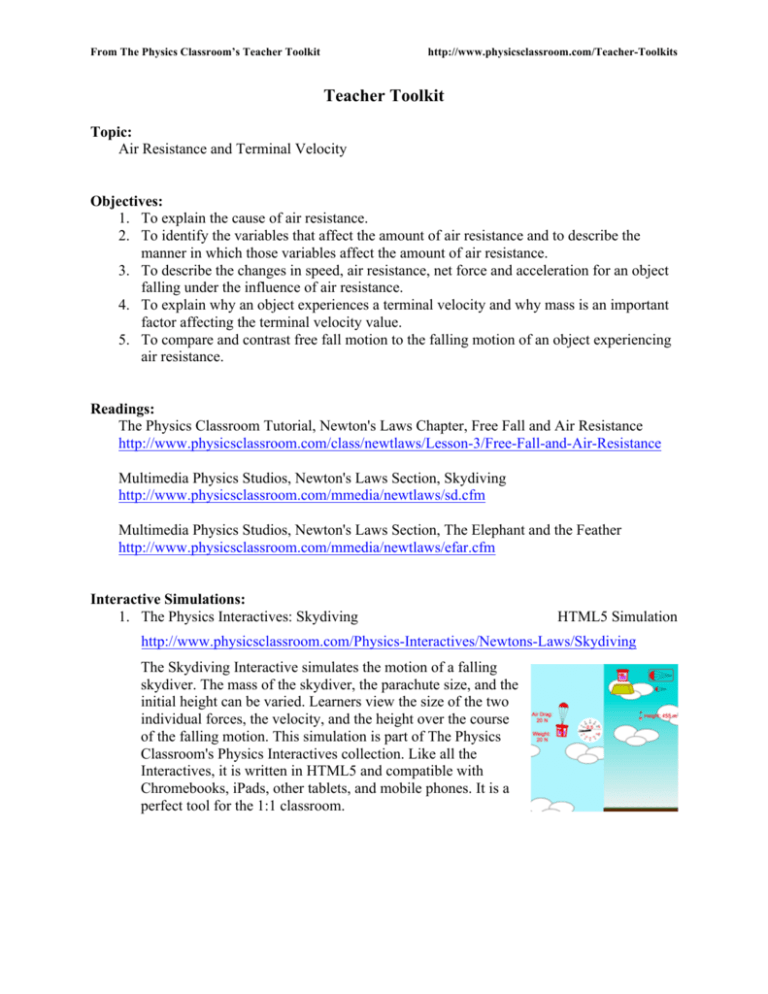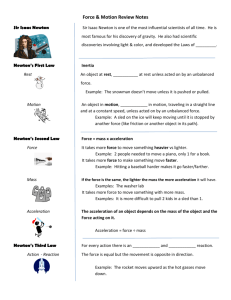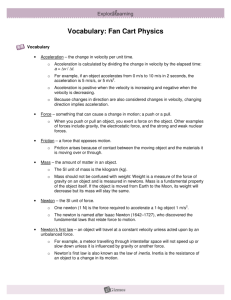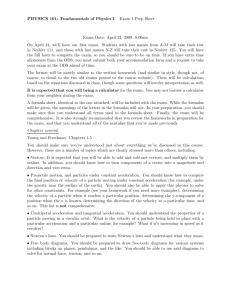
From The Physics Classroom’s Teacher Toolkit
http://www.physicsclassroom.com/Teacher-Toolkits
Teacher Toolkit
Topic:
Air Resistance and Terminal Velocity
Objectives:
1. To explain the cause of air resistance.
2. To identify the variables that affect the amount of air resistance and to describe the
manner in which those variables affect the amount of air resistance.
3. To describe the changes in speed, air resistance, net force and acceleration for an object
falling under the influence of air resistance.
4. To explain why an object experiences a terminal velocity and why mass is an important
factor affecting the terminal velocity value.
5. To compare and contrast free fall motion to the falling motion of an object experiencing
air resistance.
Readings:
The Physics Classroom Tutorial, Newton's Laws Chapter, Free Fall and Air Resistance
http://www.physicsclassroom.com/class/newtlaws/Lesson-3/Free-Fall-and-Air-Resistance
Multimedia Physics Studios, Newton's Laws Section, Skydiving
http://www.physicsclassroom.com/mmedia/newtlaws/sd.cfm
Multimedia Physics Studios, Newton's Laws Section, The Elephant and the Feather
http://www.physicsclassroom.com/mmedia/newtlaws/efar.cfm
Interactive Simulations:
1. The Physics Interactives: Skydiving
HTML5 Simulation
http://www.physicsclassroom.com/Physics-Interactives/Newtons-Laws/Skydiving
The Skydiving Interactive simulates the motion of a falling
skydiver. The mass of the skydiver, the parachute size, and the
initial height can be varied. Learners view the size of the two
individual forces, the velocity, and the height over the course
of the falling motion. This simulation is part of The Physics
Classroom's Physics Interactives collection. Like all the
Interactives, it is written in HTML5 and compatible with
Chromebooks, iPads, other tablets, and mobile phones. It is a
perfect tool for the 1:1 classroom.
2. Free Fall Air Resistance Model
Interactive Simulation
http://www.thephysicsfront.org/items/detail.cfm?ID=10002
Powerful model for introductory physics. The blue
ball falls under the influence of gravity alone; the red
ball is influenced by air resistance. Students will have
fun adjusting the air resistance, initial height, and
velocity. Challenge them to find out gravitational
constants on other planets and use those values to
change the air resistance. (What would happen, for
example, on a planet with low gravity but a dense
atmosphere?) Written by respected EJS modeling author Andrew Duffy, professor of
physics at Boston University. Available as a Java file only at this time.
Video and Animation:
1. Discovery Education: Physics of Skydiving
3-minute Video
https://www.youtube.com/watch?v=ur40O6nQHsw
Good choice for a lesson warm-up – this short video
concisely illustrates the forces on a skydiver from the
moment she jumps to the moment her feet hit ground. We
like it because it’s a very visual way to depict the effects of
air resistance. The jumper reaches terminal velocity twice
during her descent: once before she opens the parachute and
again after she deploys the chute. The video will help kids
understand that terminal velocity involves a balance of
gravity and drag forces.
2. Elastic Science: James Bond and Terminal Velocity
6-minute Video
https://www.youtube.com/watch?v=lBk62CWsGok
This film clip uses the opening sequence of the James
Bond film “Moonraker” to illustrate the interaction of
forces in skydiving. James Bond is pushed out of an
airplane without a parachute. What will he do to
overcome drag and increase his velocity to catch up to
the villain with the parachute? The author has
annotated the video to let students ponder the physics
as they watch. Have fun with it! (This video also
serves to dispel the misconception that velocity decreases as an object approaches
terminal velocity.)
©The Physics Classroom, All Rights Reserved
This document should NOT appear on other websites.
3. Apollo 15 Historic Video: The Hammer and the Feather
1.5 minute video
https://www.youtube.com/watch?v=03SPBXALJZI
At the end of the Apollo 15 moon walk,
Commander David Scott performed a live
demonstration for TV cameras. He held out a
geologic hammer and a feather and dropped them
at the same time. Because the moon has no
atmosphere (thus no air resistance), the feather and
hammer both hit the ground at the same time. As
Galileo had concluded hundreds of years before - all objects released together fall at the
same rate of gravitational acceleration, regardless of mass. Caveat: This video is in the
public domain, so there are many YouTube versions of it. This one was the highest
quality we could locate. NASA also has a library archive for all video clips associated
with Apollo 15, but the format is limited to Quicktime or MPG. (1 minute, 20 seconds)
Labs and Investigations:
1. The Physics Classroom, The Laboratory, Coffee Filter Skydiving Lab
Using a motion detector, students analyze the falling motion of a coffee filter and
investigate how the velocity and the acceleration changes over time.
2. The Physics Classroom, The Laboratory, From a Feather to an Elephant
Using video analysis and footage of falling filters of varying mass, students determine
the relationship between mass and terminal velocity. Mass is varied by nesting varying
number of identical filters together.
3. The Physics Classroom, The Laboratory, Falling Body Spreadsheet Lab
Students utilize a spreadsheet to explore the motion of a falling body under the influence
of air resistance. This open-ended exploration promotes experimental design and control
of variables.
Link: http://www.physicsclassroom.com/lab - nl
Demonstration Ideas:
1. MIT Tech TV: Feather and Coin in a Vacuum
2-minute Video Demonstration
http://techtv.mit.edu/collections/physicsdemos/videos/9253-feather-and-coin-in-a-vacuum
The free fall of coins and feathers are compared, first in
a tube full of air, next with an evacuated vacuum pump.
With air resistance, the feathers fall more slowly. In a
vacuum, the objects fall at the same rate. This demo is
also a Misconception Buster – See “Common
Misconception #1” below.
Teachers: Of course, you can do this demo in class if
you have a vacuum pump. Here’s a link to lab procedures for performing the demo
(from the UK’s Institute of Physics) Lab Procedure: The Guinea and the Feather
©The Physics Classroom, All Rights Reserved
This document should NOT appear on other websites.
Minds On Physics Internet Modules:
The Minds On Physics Internet Modules are a collection of interactive questioning modules
that target a student’s conceptual understanding. Each question is accompanied by detailed
help that addresses the various components of the question.
1. Newton's Laws of Motion, Ass’t NL10 - Free Fall Acceleration
2. Newton's Laws of Motion, Ass’t NL11 - Air Resistance
Link: http://www.physicsclassroom.com/mop
Concept Building Exercises:
1. The Curriculum Corner, Newton's Laws, Air Resistance and Terminal Velocity
2. The Curriculum Corner, Newton's Laws, Skydiving
3. The Curriculum Corner, Newton's Laws, The Elephant and the Feather
Link: http://www.physicsclassroom.com/curriculum/newtlaws
Problem-Solving Exercises:
1. The Calculator Pad, Newton's Laws of Motion, Problems #17, 19, 29
Link: http://www.physicsclassroom.com/calcpad/newtlaws/problems
Science Reasoning Activities:
1. Science Reasoning Center, Newton's Laws, Coffee Filter Physics Lab
Link: http://www.physicsclassroom.com/reasoning/newtonslaws
Real Life Connections:
1. Air Resistance in Orbit
Video-Based Classroom Activity
http://www.wired.com/2013/04/air-resistance-in-orbit/
At the altitude of the International Space Station, there
isn’t much air. To stay in orbit, the ISS get regular
“reboosts” from an Automated Transfer Vehicle. The
boost causes the ISS to accelerate back up to proper orbit.
But what happens to the astronauts when the ISS
accelerates during a reboost? This 2-minute video shows
you: if the astronauts don’t anchor themselves, they will
not move forward with the spacecraft – they appear to float backwards. But
wait…..that’s not all. Veteran physics blogger Rhett Allain has used this video as the
basis of a really creative class activity to determine the ATV thrust based on video
analysis of the astronauts’ motion inside the ISS cabin. He takes you step-by-step
through the entire process of problem set-up, quantitative analysis using kinematic
equations, and help with data fitting.
©The Physics Classroom, All Rights Reserved
This document should NOT appear on other websites.
2. NASA Glenn Research Center: Factors that Affect Drag
Want to extend the learning on air resistance, or
provide extra challenges for students with high
interest? NASA’s Glenn Research Center has a
nicely-organized set of introductory resources on
aerodynamics. Here’s the home page: NASA:
Aerodynamics Index
Reference Material
Here are specific pages you might find useful for
your unit on Air Resistance:
• NASA: Size Effects on Drag
• NASA: Factors That Affect Drag
• NASA: Shape Effects on Drag
• NASA: The Drag Coefficient
• NASA: The Drag Equation
Common Misconceptions
1. Heavier objects fall faster because they experience less air resistance.
Air resistance opposes the motion of a falling object. As an object falls, air resistance act
upwards so as to reduce the net force. Heavy objects fall faster than lighter objects
because the downward force (gravity) is bigger. A more massive object must accelerate
to higher speeds in order to acquire an air resistance force that is large enough to balance
the downward force. Thus, a heavier object will experience a greater amount of air
resistance than a lighter object; it’s just that it must have a higher terminal velocity value
in order to obtain this larger air resistance value.
2. As an object approaches terminal velocity, both its velocity and acceleration decrease.
As a falling object approaches its terminal velocity, the net force is observed to decrease
as the air resistance force increases. This decrease in net force is accompanied by a
decreasing acceleration. These two statements are true. What often follows in a student's
mind is the incorrect perception that the velocity is decreasing. This false belief
exemplifies a student’s tendency to confuse concepts of velocity and acceleration. The
decrease in acceleration should be correctly understood to mean that the falling object is
still picking up speed, just at a lower rate of acceleration. If the object were equipped
with a speedometer, the needle would continue to show an increase in speed; however
the rate at which the needle moves upward would decrease.
Elsewhere on the Web:
1. The Physics Classroom's Skydiving and Parachuting Gallery
https://www.flickr.com/photos/physicsclassroom/galleries/72157625443219376/
This Flickr gallery of photos serves as either a suitable introduction to the topic of
skydiving and parachuting or an enrichment activity for students interested in the topic.
The gallery features 18 incredible photos from Flickr photographers, each annotated by
a short description written in a light-hearted and everyday language. A student favorite.
©The Physics Classroom, All Rights Reserved
This document should NOT appear on other websites.
Standards:
A. Next Generation Science Standards (NGSS) – Grades 9-12
Performance Expectations – Physical Science
• Forces and Motion-High School HS-PS2-1: Analyze data to support the claim that
Newton’s Second Law of Motion describes the mathematical relationship among the
net force on a macroscopic object, its mass, and its acceleration. (Strong Alignment)
Disciplinary Core Ideas – Physical Science
• Forces and Motion-Middle School MS-PS2.A.ii The motion of an object is
determined by the sum of forces acting on it; if the total force on the object is not zero,
its motion will change. The greater the mass of the object, the greater the force needed
to achieve the same change in motion. For any given object, a larger force causes a
larger change in motion. (Strong Alignment)
• Forces and Motion-High School PS2.A.i: Newton’s Second Law accurately predicts
changes in the motion of macroscopic objects. (Strong Alignment)
Crosscutting Concepts
Structure and Function
• High School: The functions and properties of natural and designed objects and systems
can be inferred from their overall structure, the way their components are shaped and
used, and the molecular substructures of its various materials.
Stability and Change
• High School: Change and rates of change can be quantified and modeled over very
short or very long periods of time.
Nature of Science: Order & Consistency in Natural Systems
• High School: Scientific knowledge is based on the assumption that natural laws
operate today as they did in the past and they will continue to do so in the future.
Science and Engineering Practices
Practice #1: Analyzing and Interpreting Data
• High School: Analyze data using tools, technologies, and/or models (e.g.,
computational, mathematical) in order to make valid and reliable scientific claims.
(Strong alignment)
Practice #2: Developing and Using Models
• High School: Use a model to provide mechanistic accounts of phenomena. (Strong
alignment)
Practice #5: Using Mathematics and Computational Thinking
• High School: Create or revise a computational model or simulation of a phenomenon,
process, or system. (Strong alignment)
• High School: Use mathematical representations of phenomena or design solutions to
describe and/or support claims and/or explanations. (Strong alignment)
©The Physics Classroom, All Rights Reserved
This document should NOT appear on other websites.
B. Common Core Standards for Mathematics (CC) – Grades 9-12
Standards for Mathematical Practice:
• Reason abstractly and quantitatively
• Model with mathematics
Functions
• High School F-IF.4 For a function that models a relationship between two quantities,
interpret key features of graphs and tables in terms of the quantities, and sketch graphs
showing key features given a verbal description of the relationship.
• High School F-IF.6 Calculate and interpret the average rate of change of a function
(presented symbolically or as a table) over a specified interval. Estimate the rate of
change from a graph.
Linear, Quadratic, and Exponential Models
• High School F-LE.1.b Recognize situations in which one quantity changes at a
constant rate per unit interval relative to another.
• High School F-LE.5 Interpret the parameters in a linear or exponential function in
terms of a context.
C. Common Core Standards for English/Language Arts (ELA) – Grades 9-12
Note: Flesch-Kincaid Reading Ease Score for text in The Physics Classroom TutorialNewton’s Second Law: 61.94, correlating to Grade 8.
Gunning-Fogg Index score: Grade 9
Reading Standards: Literacy in Science and Technical Subjects– Key Ideas & Details
• High School RST11-12.3 Follow precisely a complex multistep procedure when
taking measurements or performing technical tasks; analyze the specific results based
on explanations in the text.
• High School RST.11-12.2 Determine the central ideas or conclusions of a text;
summarize complex concepts, processes, or information presented in a text by
paraphrasing them in simpler but still accurate terms.
Reading Standards: Literacy in Science and Technical Subjects – Integration of
Knowledge and Ideas
• High School RST.11-12.7 Integrate and evaluate multiple sources of information
presented in diverse formats and media (e.g., quantitative data, video, multimedia) in
order to address a question or solve a problem.
• High School RST.11-12.9 Synthesize information from a range of sources (e.g. texts,
experiments, simulations) into a coherent understanding of a process, phenomenon, or
concept.
Reading Standards: Literacy in Science and Technical Subjects – Range of Reading
and Level of Text Complexity
• High School RST.11-12.10 By the end of Grade 10, read and comprehend
science/technical texts in the Grade 9-10 text complexity band independently and
proficiently.
©The Physics Classroom, All Rights Reserved
This document should NOT appear on other websites.
D. College Ready Physics Standards (Heller and Stewart)
Standard 3: Newton’s Laws of Motion – Grades 9-12
Objective 3.2: Forces and Changes in Motion – Middle School
• M.3.2.2 – Newton’s second law of motion includes the following ideas:
a. When multiple forces are acting on an object, the change in motion of the
object is determined by the sum of the forces (Newton’s second law),
which can be found using vector addition. The sum of the forces is not a
real force caused by an interacting object; it is the single force that could
replace the original multiple forces and cause the same change in motion.
• M.3.2.3 – The forces acting on an object can be represented by arrows
(vectors) drawn on an isolated picture of the object, called a force diagram.
The direction of each arrow shows the direction of the push or pull. Forces are
labeled: (type of interaction) push or pull of (interacting object) on the (object
of interest). For example: “drag push of the wind on the sails of the boat”.
Objective 3.2: Forces and Changes in Motion – High School
• H.3.2.1 – Newton’s second law of motion includes the following ideas:
a. The linear acceleration of an object is directly proportional to the vector
sum of all the forces acting on the object and inversely proportional to the
object’s mass (a = F/m). The vector sum of all the forces (net force) is not
a real force caused by an interaction with another object. The single force
that could replace the original multiple forces and cause the same
acceleration of the object is the vector sum of forces.
b A special case of Newton’s second law occurs when the vector sum of all
the forces (net force) on an object is zero. In this case, there is no
acceleration and the object remains at rest or maintains a constant speed
and a constant direction of motion.
©The Physics Classroom, All Rights Reserved
This document should NOT appear on other websites.









